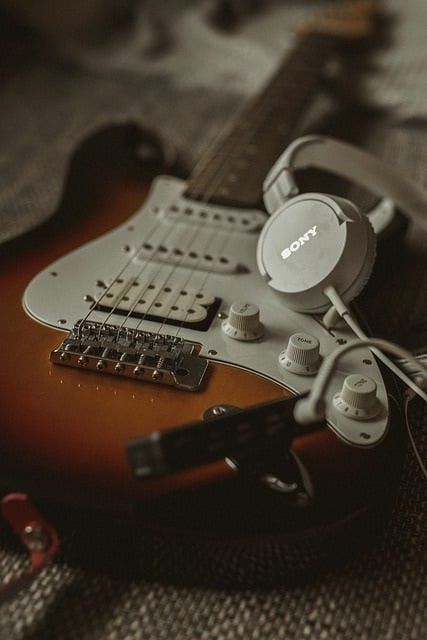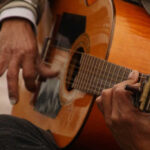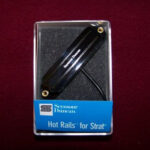Playing electric guitar through headphones is a fantastic way to practice without disturbing anyone around you. You can easily connect your electric guitar to headphones by using an amp with a headphone jack or a guitar interface, and guitarplayers.net can show you how. With the proper setup, you can enjoy a private, high-quality jam session any time, any place.
Let’s explore the world of silent guitar playing! Whether you’re looking to improve your playing, record music, or just enjoy some quiet time, guitarplayers.net has you covered. Discover the joy of private practice and unlock your musical potential with these clever solutions and find LSI keywords such as silent guitar practice, headphone amp for guitar, and guitar audio interface.
1. Why Play Electric Guitar Through Headphones?
Why would someone want to play guitar through headphones?
 Electric guitar leaning against an amplifier
Electric guitar leaning against an amplifier
It’s often a matter of necessity more than preference. While many guitarists love the powerful sound of an amp, there are many reasons why silent practice is essential. As populations grow and living spaces shrink, the need to keep the volume down is becoming increasingly important. You might have close neighbors, live in a small apartment, or simply need to avoid disturbing family members. The good news is that technology has caught up with the need, offering many options for silent guitar practice. According to a study by the National Association of Music Merchants (NAMM) in 2024, 68% of guitar players use headphones for practice due to noise constraints.
Digital technology has also made its mark. Even professionals playing in stadiums and arenas use digital solutions like Kemper and Fractal. This means that no matter your skill level, you can benefit from the convenience and quietness of playing through headphones.
2. Common Scenarios Where Headphones Are a Must
Here are some typical scenarios where playing guitar through headphones becomes essential:
- Family Harmony: When you need to practice without disturbing family members.
- Close Neighbors: When you live in an apartment building where loud music isn’t appreciated, especially late at night.
- Playing On The Road: When you’re traveling or on tour and need to practice without annoying your bandmates.
- Traveling: When you want to bring your guitar on vacation but don’t have room for an amp.
- Late-Night Inspiration: When a creative spark hits you late at night and you want to play without waking anyone up.
3. Solutions for Quiet Electric Guitar Practice
Let’s explore the possible solutions for practicing your guitar quietly. From compact headphone amps to advanced audio interfaces, there’s a method to suit every player and situation.
3.1. Guitar Headphone Amplifiers
Guitar headphone amps have revolutionized silent practice. These compact devices plug directly into your guitar and provide a headphone jack for private jamming.
- Convenience: Small enough to fit in your pocket, they’re perfect for on-the-go practice.
- Affordability: They are one of the most budget-friendly options available.
- Effects: Many models come with built-in effects like distortion, reverb, and delay.
The most famous example is the Vox amPlug, known for its simple, amp-like controls and added effects. You can control tone, gain, and volume, and add effects to your signal.
3.1.1. How Guitar Headphone Amps Work
Older versions like the Vox amPlug plug directly into the guitar, with headphones connecting to the amp itself. Modern versions like the Boss-Waza Air Wireless use Bluetooth technology, allowing you to play without cables. The Boss-Waza Air even adjusts to your head movements, mimicking the sound of a real amp in a room, creating a 3D experience. According to Boss, the Waza-Air Wireless Personal Guitar Amplification System provides “authentic tube amp sound and response with groundbreaking spatial technology.”
With Bluetooth connectivity, you can also play along with music from another source using 50 effects and Boss Amp Modeling.
3.2. Amplifiers With a Headphone Out
Using an amplifier with a headphone output is a great way to replicate your normal playing experience in stealth mode. This method allows you to use your existing pedal setup and hear the full chain through your headphones.
- Familiarity: It allows you to play as you normally would but in a quieter setting.
- Pedal Compatibility: You can use your entire pedal chain.
- Versatility: Many modern amps include this feature due to its growing popularity.
To use this method, you’ll need a guitar amp with a headphone output. Check your amp’s owner’s manual to locate the output, which is usually a 1/4” input, so you might need an adapter. It’s also crucial to ensure the headphone input disconnects the speaker to avoid disturbing others.
3.2.1. Guitar Amps With Headphone Outputs
- YMC 15-Watt Electric Guitar Combo Amplifier: A budget-friendly option with a headphone jack.
- Fender Mustang LT25 Digital Guitar Amplifier: Offers a range of digital tones and a headphone output for silent practice.
- Marshall Amps Guitar Combo Amplifier: Delivers classic Marshall tones with the convenience of a headphone jack.
3.3. Effects Processors
Effects processors often come with a headphone input, making them an excellent option for silent practice. Many also include amp simulators, offering a wide range of tones.
- Variety: Access to a wide range of effects and amp models.
- Convenience: Typically features 1/8” jacks, so you likely won’t need an adapter for your headphones.
- Portability: Easy to transport for practice on the go.
Look for the headphone input on the back of the unit. Consider using a coil-wire pair of headphones or a Bluetooth adapter to avoid being tethered to the processor by a cable.
3.4. Tablet and Smartphone Adapters
You can also use your smartphone or tablet to play guitar through headphones. Adapters like the iRig and iRig 2 allow you to plug your guitar directly into your device.
- Portability: Use your existing smartphone or tablet.
- Recording: Create music on the spot with a DAW (Digital Audio Workstation) app.
- Versatility: Access to a wide range of amp simulations and effects apps.
3.4.1. How Tablet and Smartphone Adapters Work
These adapters translate your guitar’s analog signal into digital information that your phone or tablet can read. Once connected, you can download a DAW and start creating music.
3.4.2. Great Free iOS Apps to Use With Your iRig
- GarageBand: An all-in-one software for creating and recording music.
- Bias Amp 2: Provides access to 36 different amp simulations.
- JamUp: A multi-amp, multi-effects processor with endless possibilities.
3.5. Audio Interface and a Computer
Using an audio interface with a computer opens up a whole new world for your guitar playing. This setup allows you to record, produce, and experiment with various tones and effects.
- Recording Capabilities: Easily record your playing using a DAW.
- Versatility: Access to a vast library of amp simulations and effects plugins.
- Production: Create and mix your own music.
3.5.1. How Audio Interfaces Work
The audio interface translates your guitar’s analog signal into digital data that your computer can read and modify. It then converts the modified signal back into analog data for your headphones. This process happens with minimal latency, allowing for real-time playing and recording.
3.5.2. Software & Hardware You Need
- Hardware: Audio interface, computer, and connecting cables.
- Software: Guitar-playing software such as Amplitube, Bias FX 2, or GuitarRig, and a DAW like Cubase, Pro Tools, Logic Pro, or Ableton for recording and mixing.
By investing in software and hardware, you can take your guitar playing to the next level and dive into the world of music production.
4. The Yamaha Silent Guitar
What about playing an acoustic guitar with headphones? The Yamaha Silent Guitar offers a unique solution for acoustic players who need to practice quietly.
- Quiet Practice: Designed to be extremely quiet compared to traditional acoustic guitars.
- Portability: Features a detachable body and a specially-made gig bag for easy transportation.
- Headphone Jack: Allows for silent practice with headphones.
The Yamaha Silent Guitar is perfect for those who love the sound of acoustic instruments but need to practice without disturbing others. Yamaha touts this instrument as “the ideal instrument for practice, travel, and stage performance.”
5. Best Guitar Amp Headphones
Are there headphones designed specifically for electric guitars? What qualities make a pair of headphones ideal for guitar practice?
- Comfort: Essential for long practice sessions.
- Closed-Back Design: Prevents sound from leaking out and keeps external noise out.
- Sound Quality: Clear and balanced sound reproduction for accurate monitoring.
While there aren’t specific headphones exclusively for guitar amps, some models are better suited for guitar practice than others. Comfort and closed-back design are the most important factors.
The Audio Technica M50x are a popular choice, offering comfort and excellent sound quality.
6. How To Play Guitar Through Headphones: FAQs
Let’s address some common questions about playing guitar through headphones.
6.1. Can I plug my headphones into my guitar?
No, the signal produced by guitars is too weak to drive headphones. You need an amplifier to boost the signal, whether analog or digital.
6.2. Can I play acoustic guitar with headphones?
Yes, you can use most headphone amplifiers with any guitar. However, acoustic guitars are louder than electric guitars, so the Yamaha Silent Guitar is an excellent solution for truly silent acoustic practice.
6.3. Can I plug my guitar into my Bluetooth headphones?
Not directly. You need a Bluetooth-enabled headphone amp like the Boss Waza Air, which connects to your guitar and transmits the sound to your Bluetooth headphones.
6.4. Can I play guitar and music through my headphones?
Yes, many multi-effects processors, loopers, and guitar amps have a line-in input that allows you to plug in a music source and play along.
6.5. Can you plug headphones into a guitar amp?
Some guitar amps have a headphone jack that disconnects the speaker, allowing you to play silently through headphones. Check your amp’s manual to see if it has this feature.
Conclusion
Playing guitar through headphones is a convenient and effective way to practice without disturbing others. Whether you choose a headphone amp, an amp with a headphone out, or an audio interface, there’s a solution that fits your needs.
Ready to take your guitar playing to the next level? Visit guitarplayers.net for lessons, reviews, sheet music, and to join our community of guitar enthusiasts! Contact us at Address: 1140 Boylston Street, Boston, MA 02215, United States or Phone: +1 (617) 747-2261.
Happy (silent) playing!


